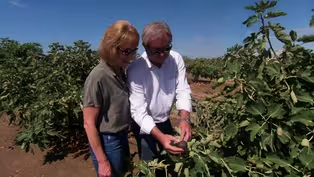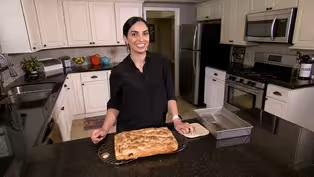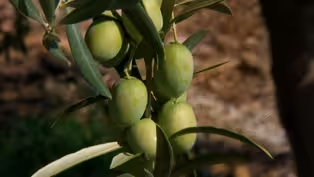
South Dakota Cattle Ranch
Clip: 6/30/2023 | 4m 30sVideo has Closed Captions
A family-owned South Dakota cattle ranch is trying some innovative practices.
A family-owned South Dakota cattle ranch is trying some innovative practices borrowed from abroad.
Problems playing video? | Closed Captioning Feedback
Problems playing video? | Closed Captioning Feedback
America's Heartland is presented by your local public television station.
Funding for America’s Heartland is provided by US Soy, Sustainable Agriculture Research and Education, Rural Development Partners, and a Specialty Crop Grant from the California Department of Food and Agriculture.

South Dakota Cattle Ranch
Clip: 6/30/2023 | 4m 30sVideo has Closed Captions
A family-owned South Dakota cattle ranch is trying some innovative practices borrowed from abroad.
Problems playing video? | Closed Captioning Feedback
How to Watch America's Heartland
America's Heartland is available to stream on pbs.org and the free PBS App, available on iPhone, Apple TV, Android TV, Android smartphones, Amazon Fire TV, Amazon Fire Tablet, Roku, Samsung Smart TV, and Vizio.
Providing Support for PBS.org
Learn Moreabout PBS online sponsorship♪♪ About 25 miles outside of Lemmon, South Dakota, just over the North Dakota state line, the Gaugler Farm sits on 4,000 acres of rolling hills.
In the nearly 100 years that the Gaugler family has farmed here, things have certainly changed.
Yet, they've also stayed the same.
[Drew Gaugler] A lot of what we're doing today has been done already.
I mean, it's not new, but we have some small pieces of technology that enable us to change how we're going about it.
Drew Gaugler and his sister Erin grew up on this land.
Both went away to college.
After graduating as a mechanical engineer, Drew worked in Africa, New Zealand and Australia, gaining valuable insight into farming practices around the world.
Erin is finishing up her PhD in Range Sciences.
Their parents, Jodie and Harold Gaugler, both hold master's degrees and share a passion for learning with their family.
[Harold] They both had the opportunity to... to see the world, and they've brought a lot of things that... that the United States people don't do.
They dug wells and used solar to pump them.
They planted trees to provide a windbreak for the cattle.
And they created a habitat that attracts wildlife to help foster a healthier functioning landscape.
[Harold] Those are all things that... [Jodie] from Australia.
- ...that we wouldn't have done.
Those are things that younger generations can do.
One of the new practices that Drew and Erin brought to the ranch: bale grazing.
It's a way to improve the soil on this land that has been farmed for almost a century.
[Erin] Bale grazing is really a regenerative practice.
It's how we are taking hay fields that have been, um, reaching the end of their productive period and we regenerate them back into being highly productive.
The Gauglers spread out bales in the fall that feed their livestock through the winter.
At the same time, cattle are kept in smaller areas and rotated through different pastures every week or so.
This means the manure they produce doesn't pile up and need to be hauled out.
Instead, the cattle help fertilize the land by spreading the manure, just by walking around.
[Drew] It's like mulching for a garden, but it's just on a larger scale.
[Erin] We're not spending all of that time running the tractor, burning the fuel, and the cattle are working a little bit more for us and helping us accomplish our goals.
Cattle aren't the only livestock working to improve the soil.
You'll also find another type of species- sheep.
The reason?
[Erin] Different livestock function in different ways.
The sheep forage and distribute manure differently than cattle, which improves soil health and forage production across the landscape.
The manure and runoff produced by the livestock flow into slits that the Gauglers cut into the land.
It's called keyline cultivation, and it's yet another way the family hopes to make their land more sustainable.
It's a way of farming once unfamiliar to many in this region.
[Jodie] Sometimes it takes time and input from the younger generation to say, "Hey, Ma, why are you doing that?"
And so, just taking time to stop and think why we do things.
People talk about us, and I think that's good.
They watch what we do.
Some support us, some think we're crazy.
But that's all right.
We do what we think is right, and what works for us.
[Erin] In order to stay in business, we have to consider what sustainability is and what that means on the resources that you manage.
[Drew] For me, it's doing what's right for the land, but also doing what keeps you in business, so you can continue to do what's right for the land.
[Harold] It's a place that we all call home, and... and it's really nice that it's going to be handed down to another generation and they're going to do the same thing we are and... and hopefully, take it beyond what we've done.
[Jodie] I was just going to say, they won't do it the same.
[Harold] Nope.
Maybe not the same, but the Gauglers do believe that with the practices they're implementing now, their family will be farming on this land for decades to come.
California Figs and Pistachios
Video has Closed Captions
Clip: 6/30/2023 | 4m 43s | See what it takes to grow figs and pistachios in California’s Central Valley. (4m 43s)
Focaccia Bread – Farm to Fork with Sharon Profis
Video has Closed Captions
Clip: 6/30/2023 | 5m 11s | Follow along as we prepare an Olive and Goat Cheese Focaccia bread recipe. (5m 11s)
Video has Closed Captions
Clip: 6/30/2023 | 5m 37s | Olives grown near Sacramento are rushed to a nearby processing plant and mill. (5m 37s)
Providing Support for PBS.org
Learn Moreabout PBS online sponsorshipSupport for PBS provided by:
America's Heartland is presented by your local public television station.
Funding for America’s Heartland is provided by US Soy, Sustainable Agriculture Research and Education, Rural Development Partners, and a Specialty Crop Grant from the California Department of Food and Agriculture.


















